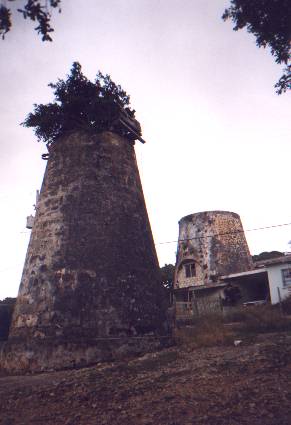
Groups of windmills 🌍
A single windmill often makes an impressive sight on its own. There are
however places where windmills can be seen in larger groups, which is an
even more impressive sight.
The reasons should be obvious - if a site offers suitable wind conditions,
then building more mills there can use make more use of that wind.
Where mills occur in pairs, the reason was often simply one of expansion
(and to a certain extent redundancy). A successful miller could increase
capacity by adding an additional mill more conveniently than they could
rebuild an existing mill with the required larger capacity.
Britain
British examples of windmill groups are now mostly resticted to just
pairs of corn mills, though there are examples of (quite widely spaced)
groups of drainage mill, principally in Norfolk.
Jack and Jill, Clayton, Sussex
Jack and Jill
are a familiar pairing of a tower mill and a post mill, occupying a prominent position on the South Downs in Sussex. In fact there is actually the remaining roundhouse of the earlier
Duncton Gate post mill just alongside Jack, making this a triplet of mills.
Drinkstone, Suffolk
The Drinkstone mills consist of a smock mill and a post mill.
Cross in Hand, Sussex
The pair of post mills at Cross in Hand known as
Little Mill, and New Mill,
worked together until Little Mill was badly damaged in 1903. Soon after it was reduced to just the roundhouse seen today, but New Mill continued regular work up to 1969.
Outwood, Surrey

The post mill at
Outwood
survives in working order, but the smock mill collaped 9th Nov 1960.
Ireland
Skerries mills complex
Skerries Mills on the North Fingal coast, about 20 miles north of Dublin, is home to 3 mills -
a five sailed tower mill,
a four sailed thatched tower mill,
and a watermill for good measure.
Estonia
Angla
The "windmill hill" at
Angla, on the island of Saaremaa, once had nine windmills in a row.
Of these, 5 survive, including one smock mill, and 4 classic Estonian post mills.
The island of Saaremaa once had hundreds of windmills, and there are plenty
more examples of groups of remains, though often in extreme states of
dereliction.
Tallinn - Rocca Al Mar
The Estonian Open Air Museum at Rocca Al Mar near Tallinn has a total of 6
windmills which have been moved to the site. Of these, 3 of the post mills
have been arranged together to show how a windmill hill would have appeared.
Spain

Consuegra.
The hillside in Consuegra, La Mancha hosts perhaps the most familiar group
of windmills, since they regularly feature in advertising and other
photographs. The group consists of 11 windmills, and one castle!
[Consuegra]
Spain also has other large groups of mills in the
La Mancha region,
notably the 10 mills at
Campo de Criptana
and at Mota del Cuervo.
Mallorca
There are a number of groups of flour mills that remain in Mallorca - though
in most cases the groups are now much depleted compared to the size they
once were. Examples around the capital of Palma include the remaining groups
at Es Jonquet (5), Industria (4), and Molinar (2).
The Netherlands
There are two particularly notable groups of windmills in The Netherlands.
The 19 mills at
Kinderdijk were used to pump water, whilst the group of mills at
Zaanse Schans were mostly used for industrial purposes.
Turkey

Bodrum, Turkey
The hill sides above Bodrum have a group of windmills ruins.
Japan
The Japanese are not a windmilling nation, but they are very keen on their theme parks. One of these, the
Huis Ten Bosch
Dutch themed resort near Nagasaki, has a group of windmills, based roughly on Kinderdijk.
Barbados

Rock Hall, St Peter
Most of the windmills in Barbados were used to crush sugar cane, and as such
each plantation had its own. A number of smaller mills were also built that
pumped water, and a few examples of such a pairing remain, though
unfortunately not in very good conditions. Examples can be found at
Apes Hill, St James, and at Rock Hall, St Peter.
Greece
Crete
There are a group of 24 preserved stone windmills at
Lasithi.
In addition, the
Platea of Lasithi has many thousands of small irrigation mills.
Mykonos
Although not all the mills that once lined the
harbour of Mykonos
still survive, there's an impressive row of visually restored mills still to be seen.
USA
Golden Gate Park, San Francisco


Dutch windmill, and Murphy windmill
The
pair of windmills at the Western end of Golden Gate Park,
were built in the early 1900's to pump water to irrigate the rest of the park. The northern Dutch Windmill was cosmetically restored a good number of years ago, but the southern Murphy Windmill was restored much more recently.
Modern wind turbines
With the exception of a few experimental installations, (where just one turbine has been installed), most wind turbines are built in groups, commonly referred to as windfarms.
Particularly notable groupings can be found in the Altamont Hills in California, where favourable tax incentives have enabled this mountain pass area to be covered in thousands of turbines.
| Last updated
16/09/2025 |
Text and images © Mark Berry,
1997-2025 -
|






